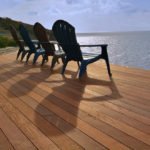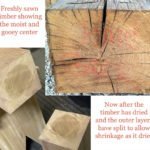
In the quest for sustainable and versatile deck alternatives, Tali wood has emerged as a prime candidate. Cumaru, a popular choice for decking, has recently been listed on Appendix II of CITES, indicating increased regulatory scrutiny that may affect its availability and cost. This development highlights the need for reliable alternatives. Tali, scientifically known as Erythrophleum spp., offers a compelling option for architects and designers seeking a durable and eco-friendly material. But more to the point, it is nearly identical to Cumaru in appearance.
Tali wood is celebrated for its durability, strength, and resistance to decay and insect damage. Its beautiful reddish-brown color adds warmth and elegance to any outdoor space. Beyond its aesthetic appeal, Tali wood is a responsible choice for those committed to sustainable forestry practices. Tali as a decking material supports sustainable forestry efforts and is an FSC product. Sourced from responsibly managed forests, Tali ensures long-term availability and environmental stewardship.
Tali vs cumaru
Honestly, these two species are really hard to tell apart. You have to look really really close at the pore structure, and even then magnification is really helpful. In other words, you can’t tell the difference. The size availability with thickness, width and length is all about the same. The key difference is that, now with Cumaru being CITES listed, Tali has become a much more attractive prospect. This is really what CITES is good for promoting: secondary and tertiary species that are overshadowed by more popular ones. Some comparisons are available here, but for a side by side look at the technical number differences between Tali, Cumaru, and Ipe, be sure to check out our Tali product page.


Durability and Longevity: Both species are very hard. Tali’s hardness is 2920 vs Cumaru at 3030. These numbers pretty much sum it up as the core resistance to damage in use as a decking board.
Resistance to Decay, Insects & Weathering: Tali and Cumaru standout features – much like most tropical decking – are their remarkable resistance to decay, insects, and weathering. These hardwoods possess natural oils and resins that act as a protective barrier, preventing rot, termite infestation, and damage from harsh weather conditions. With Tali and Cumaru decking, you can enjoy a worry-free outdoor space.
Maintenance & Care: Tali decking requires minimal maintenance to keep it looking its best. Regular sweeping and occasional washing with mild soap and water are usually sufficient to remove dirt and debris. We are big proponents of a factory applied decking stabilizer finish that we offer with all our decking orders. The factory finish provides an even coating which penetrates deeply to stabilize crazy wood movement and minimizes surface checking in bright sunlight (which is a common issue with dense tropical woods). The factory finish just nets a cleaner, more stable deck install.
Environmental Considerations & Tali Decking
Tali wood is an excellent choice for decking due to its eco-friendly attributes. As an alternative to Cumaru, Tali offers sustainability benefits that make it a top choice for environmentally-conscious homeowners. Tali is a relative newcomer to the tropical decking market, and many of the lessons learned from highly traded species have allowed for proper forestry management from the get go. Tali trees are harvested following strict guidelines of 1 tree per a 3 football field size area every 30 years. This keeps the forest regenerating in a natural way that promotes biodiversity and healthy trees, which as a result also happen to produce excellent quality boards.
When comparing Tali with composite decking in terms of sustainability, Tali stands out as the better option. Composite decking often contains non-biodegradable materials and may contribute to landfill waste. In contrast, Tali decking is made from natural wood that is biodegradable and renewable.
For those concerned about the sourcing of Tali wood, there are certifications and standards in place to ensure sustainable practices. Look for decking products sourced from responsibly managed forests with certifications such as the Forest Stewardship Council (FSC) or the Programme for the Endorsement of Forest Certification (PEFC).
Changes in the tropical decking market should be commonplace by now, but the CITES listing of Ipe and Cumaru is a particularly difficult change to swallow. Both species are insanely popular and in high demand globally. Getting Architects and builders who are used to specifying and building with a particular species to change is a tough proposition. But by choosing Tali decking, you can have peace of mind knowing that your product is nearly indistinguishable from Cumaru and will create a visually appealing, environmentally friendly outdoor space. Its sustainable attributes, when compared to composite decking, make Tali an ideal choice for those looking to reduce their ecological footprint without compromising on quality and durability.









Leave a Reply